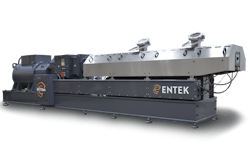By Bruce Geiselman
High throughputs and better handling of powdery materials are targets of two new Entek offerings. The company’s new HT72 co-rotating twin-screw extruder is designed for compounding and masterbatch applications where processors require medium-to-large batch production sizes and high production rates. It and Entek’s other twin-screw extruders are available in conventional configurations, as well as in a new configuration — the Vacuum Feed Technology (VFT) configuration, which is designed to better handle powdery materials.
The HT in the HT72’s name stands for “high torque,” and the extruder delivers the highest free volume at 18 torque density in the industry, resulting in high throughputs, according to the company.
“What the high torque has allowed us to do is put in a larger-size motor,” said Ryley Jones, Entek’s mechanical engineering supervisor and HT72 project lead. “It’s got a bigger drive train. You’re talking about a higher rate in terms of power per hour through your extruder as a result of that higher torque level.”
The HT72 is coupled with a large motor — up to 1,200 horsepower — for continuous 24/7/365 production, Jones said.
The extruder is designed for compounders looking for maximum uptime, high production rates and readily available overall equipment effectiveness (OEE) data, both at the machine and via remote monitoring access from mobile devices.
“Some of the key features are the real-time monitoring, giving our customers more data about how their extruder is running on a minute-by-minute basis,” Jones said. “[It’s] monitoring the oil life, oil quality and also the vibration in several different places on the machine to give our customers more information about the performance of the extruder. Our customers will be excited to add the 72 millimeter [screw extruder] to their production plants because the benefit it offers is high production rate in a fairly small footprint.”
The HT72 also is designed for easier operation and servicing.
“Some examples are mistake-proof screws and shafts,” Jones said. “When your team is assembling the screw set on a shaft, they don't have to worry about whether or not the screws are oriented the right direction because they can only go on one way, which is going to save them a lot of time.”
The extruder is compatible with standardized tools, so it uses the same size fastener in most places.
“You don’t need 15 different wrench sizes to access the different panels on the extruder and work on things,” Jones said.
The hinge guards also have been updated. Unlike traditional guards that personnel can accidentally misplace after unlatching and removing them, the guards on the HT72 stay in place so that there's no risk of losing them.
Entek is launching a real-time monitoring dashboard on the HT72.
“This is a screen that is in addition to the HMI that’s going to be located near the extruder,” Jones said. “In a quick glance, you’re going to see an update about how your extruder is performing. We’ve got OEE stats … [including] 24-hour uptime production rate … oil life and oil quality, and we have several vibration monitors installed on the machine, which is going to be really helpful to our customers in terms of preventative maintenance. As you’re watching the vibration over time, you’re going to be able to detect any failures that might be upcoming. That’s going to save a lot of downtime for our customers.”
The HT72 comes with Entek’s new patent-pending Vent Flow Sensor.
“If you’re [at] all familiar with vent flow, basically it’s a process condition upset which results in molten polymer coming up out of the extruder, either through a vent or into the vacuum system,” Jones said during an online press conference. “It creates a big mess and also a fire hazard.”
The sensor can detect potential vent-flow problems, allowing operators time to correct any processing issues before they cause problems. The device can reduce unplanned downtime and the risk of a fire. It also makes vent cleaning easier.
According to company officials, years of research went into developing the HT72 extruder.
“We are excited to be launching this new twin-screw extruder to the compounding market,” said Linda Campbell, Entek VP of sales. “It represents almost three years of research and development to produce a completely new machine that provides industry-best performance. We now have an ideal solution for those needing high throughput for continuous production of large batches of materials.”
HT72s intended to handle low-density fillers can be specified in the VFT configuration to achieve even higher throughputs.
Developed for use when compounding fluffy materials, such as talc and starch, VFT-configured extruders include a vacuum vent and screws arranged to densify or extract fluid from material processed by the extruder, according to Entek’s patent application.
“VFT is the solution if a compounder is challenged by a process that is volumetrically limited when processing low-bulk-density powdered materials,” said Dean Elliott, Entek’s technical processing manager. “Processors can achieve much higher throughput, as much as twice the output rate without VFT.”
Extruders designed in the VFT configuration do not have vents open to atmosphere. This means there’s no way for powdered materials to spew out of them, as they might when handled by conventially designed extruders.
“This prevents not only a messy situation but creates a safer work environment,” Elliott said.
The design helps to pull out air from the fluffy material to densify the material, thus allowing more material to be fed.
Bruce Geiselman, senior staff reporter
Contact:
Entek Manufacturing, Lebanon, Ore., 541-259-1068, http://entek.com
Bruce Geiselman | Senior Staff Reporter
Senior Staff Reporter Bruce Geiselman covers extrusion, blow molding, additive manufacturing, automation and end markets including automotive and packaging. He also writes features, including In Other Words and Problem Solved, for Plastics Machinery & Manufacturing, Plastics Recycling and The Journal of Blow Molding. He has extensive experience in daily and magazine journalism.






